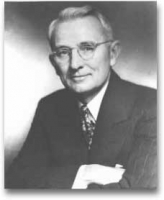閱讀戴爾·卡耐基 Dale Carnegie在百家争鸣的作品!!! | |||||||
20世紀最偉大的心靈導師,美國人戴爾·卡耐基利用大量普通人不斷努力取得成功的故事,通過演講和書喚起無數陷入迷惘者的鬥志,激勵他們取得輝煌的成功。戴爾·卡耐基是20世紀最偉大的成功學大師,美國現代成人教育之父。卡耐基在實踐的基礎上撰寫而成的著作,是20世紀最暢銷的成功勵志經典。卡耐基主要代表作有:《溝通的藝術》、《人性的弱點》、《人性的優點》、《美好的人生》、《快樂的人生》、《偉大的人物》和《人性的光輝》。這些書出版之後,立即風靡全球,先後被譯成幾十種文字,被譽為“人類出版史上的奇跡”。他一生致力於人性問題的研究,運用心理學和社會學知識,對人類共同的心理特點,進行探索和分折,開創並發展出一套獨特的融演講、推銷、為人處世、智能開發於一體的成人教育方式。接受卡耐基的有社會各界人士,其中不乏軍政要員,甚至包括幾位美國總統。千千萬萬的人從卡耐基的教育中獲益匪淺。
戴爾·卡耐基的生平簡介
戴爾·卡耐基出生於1888年11月24日,逝世於1955年11月1日,享年67歲。他一生結過兩次婚。他的第一任夫人,是法國的一位女伯爵, 1921年與他結婚,十年後離異。他的第二任夫人姚樂絲.卡耐基於1944年和他結婚,是他的門徒和事業的繼承人,並給他生一女孩,取名丹娜。
1888年11月24日,戴爾·卡耐基誕生於密蘇裏州瑪麗維爾附近的一個小市鎮。父親經營一個小小的農場。傢裏非常窮,吃不飽,穿不暖。由於營養不良,小卡耐基非常瘦小,卻長着一對與頭部不很相稱的大耳朵。
卡耐基上的小學校名很浪漫,叫玫瑰園,卻非常簡陋,衹有一間教室。他在學校可不是一個聽話的傢夥。因為調皮搗蛋,搞惡作劇,他幾次差一點被學校開除。
他那雙又寬又大的耳朵是同學們嘲弄的對象。有一次,班上一名叫山姆·懷特的大男孩與卡耐基發生了爭吵,卡耐基說了幾句很刻薄的話,懷特被激怒了,便恐嚇道:“總有一天,我要剪斷你那雙討厭的大耳朵。”他嚇壞了,幾個晚上都不敢睡覺,害怕在自己進入夢鄉以後被懷特剪掉了耳朵。
當卡耐基成名以後,仍然沒有忘記山姆·懷特。他歸納出了一番人生哲理:“要想別人對你友善,要想與同事和睦地相處,處理好上下級關係,那就絶不能去觸動別人心靈的傷疤。”卡耐基還發現,他具有與生俱來的憂鬱性格。他曾嚮朋友傾訴:煩惱伴隨着我的一生。我一直想弄明白自己的憂慮來自何處。有一天,我幫母親摘取櫻花的種子時,突然哭泣起來。母親問:“你為什麽哭?”我邊哭邊答:“我擔心自己會不會像這種子一樣,被活活埋在泥土裏。”兒時的我,擔驚受怕的事情真的不少:下雷雨時,擔心會不會被雷打死;年景不好時擔心以後有沒有食物充饑;還擔心死後會不會下地獄。稍大以後更加鬍思亂想:想自己的衣着、舉止會不會被女孩子取笑,擔心沒有女孩子願意嫁給我。但後來我發現,曾經使我非常擔心的那些事情,99%都沒有發生。”
一個如此沒有自信,幾乎被各種各樣莫名其妙的憂慮纏繞的小夥子,最終成為給別人自信、讓人們樂觀的心理激勵大師,這中間需要經歷多少磨礪,就可想而知了。
卡耐基16歲時,不得不在自傢的農場裏幹更多的活。每天早晨,他騎馬進城上學。放學後便急匆匆地騎馬趕回傢裏,擠牛奶、修剪樹木、收拾殘湯剩飯喂豬…… 在學校裏,瘦弱、蒼白的卡耐基永遠穿着一件破舊而不合身的夾剋,一副失魂落魄的樣子。有一次上數學課時,卡耐基被老師叫到黑板前解答問題。他剛走上講臺,就聽見身後爆發出一陣哄堂大笑。下課後纔明白同學們笑話他的原因。班上一名搗蛋鬼坐在他背後,在他的破夾剋的裂縫處插了一朵玫瑰花,還在旁邊貼了一張字條,寫着:“我愛你,瑞德·傑剋先生。”在英語中,瑞德·傑剋與破夾剋是諧音詞。卡耐基非常難受。回傢後他對母親說:“同學們老是笑話我穿的破衣服,我不能集中精力聽課。”媽媽說道:“你為什麽不想辦法讓他們因佩服你而尊敬你呢?不必傷心,今年秋季,我一定給你買套新衣服。”卡耐基在童年時代受到他母親很大影響。母親生性樂觀,百折不撓。一次大水災,洪水衝出了河堤,把農場的所有農作物衝得不見蹤影。父親用絶望的聲音喊道:“上帝,你為什麽老是和我過不去?我什麽時候才能走出睏境!”而母親卻十分鎮靜,她哼唱着歌,將傢園重新收拾好。母親對卡耐基寄予厚望,一直鼓勵他好好讀書,希望他將來做一名傳教士,或做一名教員。
1904年,卡耐基高中畢業後就讀於密蘇裏州華倫斯堡州立師範學院。這時,傢裏已把農場賣掉,遷到學院附近。卡耐基負擔不起市鎮上的生活費用,就住在傢裏,每天騎馬到學校去上課。他是全校600名學生中五六個住不起市鎮的學生之一。他雖然得到全額奬學金,但還必須四處打工,以彌補學費的不足。
卡耐基發現,學院辯論會及演說賽非常吸引人,優勝者的名字不但廣為人知,而且還被視為學院的英雄人物。這是一個成名和成功的最好機會。
但他沒有演說的天賦,參加了12次比賽,屢戰屢敗。三十年後,卡耐基談及第一次演說失敗時,還以半開玩笑的口吻說:“是的,雖然我沒有找出舊獵槍和與之相類似的致命東西來,但當時我的確想到過自殺…… 我那時纔認識到自己是很差勁的……”經歷失敗後,卡耐基發奮振作,重新挑戰自我。
1906年,戴爾·卡耐基一篇以《童年的記憶》為題的演說,獲得了勒伯第青年演說傢奬。這是他第一次成功嘗試,這份講稿至今還存在瓦倫斯堡州立師範學院的校志裏。這次獲勝,對他的一生産生了非同小可的影響。
他在後來的回憶中不無自豪地說:“我雖然經歷了12次失敗,但最後終於贏得了辯論比賽。更為激勵我的是,我訓練出來的男學生贏了公衆演說賽。女學生也獲得了朗讀比賽的冠軍。從那一天起,我就知道我該走怎樣的路了……”1908年,卡耐基仍舊很貧窮,但與兩年前進入師範學院時已有天壤之別了。他成了全院的風雲人物,在各種場合的演講賽中大出風頭。全院的師生對他颳目相看;但他並不滿足於此,他開始走出學院去擴大自己演講的影響了。
他原先的目標,是想在學校裏獲得學位,畢業後回到家乡的學校裏去教書。但在快畢業的那年裏,他發現同班的一個同學在暑假為國際函授學校推銷函授課,每周所得的錢,比他父親的辛勤所得還高出四倍。因此,他在1908年畢業後,便趕到國際函授學校總部所在地的丹佛市,受雇做了一名推銷員,後來他又到南奧馬哈,為阿摩爾公司販賣火腿,肥皂和豬油。他的這個推銷工作雖然很成功,但在1911年,他卻到紐約《美國戲劇藝術學院》學習演戲。一年以後,他感到自己並不具備演戲的天才,於是又回到推銷的行業裏,為一傢汽車公司當推銷員。
但這些工作都不合他的理想。他為沒有實現在大學裏夢想生活,這比賺錢更重要。他决心白天寫書,晚間去夜校教書,以賺取生活費。他想為夜校教公開演講課,因為他認為,大學時代他在公開演說方面受過訓練,有所經驗。這些訓練和經驗,掃除了他的怯懦和自卑,讓他有勇氣和信心跟人打交道,增長了做人處世的才能。於是他說服了紐約一個基督教青年會的會長,同意他晚間為商業界人士開設一個公開演講班。從此,他開始了為之奮鬥一生的成人教育事業。
戴爾·卡耐基的代表著作
《語言的突破》 (出版於1931年)
《人性的光輝》 (出版於1932年)
《人性的弱點》 (出版於1936年)
《美好的人生》 (出版於1936年)
《偉大的人物》 (出版於1943年)
《人性的優點》 (出版於1948年)
《快樂的人生》 (出版於1948年)
One of the core ideas in his books is that it is possible to change other people's behavior by changing one's reaction to them.
Biography
Born in 1888 in Maryville, Missouri, Carnegie was a poor farmer's boy, the second son of James William Carnagey (b. Indiana, February 1852 – living 1910) and wife Amanda Elizabeth Harbison (b. Missouri, February 1858 – living 1910). In his teens, though still having to get up at 4 a.m. every day to milk his parents' cows, he managed to obtain an education at the State Teacher's College in Warrensburg. His first job after college was selling correspondence courses to ranchers; then he moved on to selling bacon, soap and lard for Armour & Company. He was successful to the point of making his sales territory of South Omaha, Nebraska, the national leader for the firm.
After saving $500, Dale Carnegie quit sales in 1911 in order to pursue a lifelong dream of becoming a Chautauqua lecturer. He ended up instead attending the American Academy of Dramatic Arts in New York, but found little success as an actor, though it is written that he played the role of Dr. Hartley in a road show of Polly of the Circus.
When the production ended, he returned to New York, unemployed, nearly broke, and living at the YMCA on 125th Street. It was there that he got the idea to teach public speaking, and he persuaded the "Y" manager to allow him to instruct a class in return for 80% of the net proceeds. In his first session, he had run out of material; improvising, he suggested that students speak about "something that made them angry", and discovered that the technique made speakers unafraid to address a public audience. From this 1912 debut, the Dale Carnegie Course evolved. Carnegie had tapped into the average American's desire to have more self-confidence, and by 1914, he was earning $500 - the equivalent of nearly $10,000 now - every week.
Perhaps one of Carnegie’s most successful marketing moves was to change the spelling of his last name from “Carnagey” to Carnegie, at a time when Andrew Carnegie (unrelated) was a widely revered and recognized name. By 1916, Dale was able to rent Carnegie Hall itself for a lecture to a packed house. Carnegie's first collection of his writings was Public Speaking: a Practical Course for Business Men (1926), later entitled Public Speaking and Influencing Men in Business (1932). His crowning achievement, however, was when Simon & Schuster published How to Win Friends and Influence People. The book was a bestseller from its debut in 1936, in its 17th printing within a few months. By the time of Carnegie's death, the book had sold five million copies in 31 languages, and there had been 450,000 graduates of his Dale Carnegie Institute. It has been stated in the book that he had critiqued over 150,000 speeches in his participation in the adult education movement of the time. During World War I he served in the U.S. Army.
His first marriage ended in divorce in 1931. On November 5, 1944, in Tulsa, Oklahoma, he married Dorothy Price Vanderpool, who also had been divorced. Vanderpool had two daughters; Rosemary, from her first marriage, and Donna Dale from their marriage together.
Carnegie died at his home in Forest Hills, New York. He was buried in the Belton, Cass County, Missouri, cemetery. The official biography from Dale Carnegie & Associates, Inc. states that he died of Hodgkin's disease on November 1, 1955.
The Dale Carnegie Course
The Dale Carnegie Course is a program for businesses based on Carnegie's teachings used worldwide. It was founded in 1912 and is represented in more than 80 countries. More than 8 million people have completed Dale Carnegie Training.
The course comprises a proprietary process that uses team dynamics and intra-group activities to strengthen interpersonal relations, manage stress and handle fast-changing workplace conditions. Other subjects included are communication, creative problem-solving and focused leadership.
The course is based on a five-phase continuous improvement cycle:
1. Build Greater Self-Confidence
2. Strengthen People Skill
3. Enhance Communication Skill
4. Develop Leadership Skill
5. Improve Our Attitude
Book
* 1913: Public Speaking and Influencing Men In Business. An introduction to public speaking.
* 1932: Lincoln the Unknown. A biography of Abraham Lincoln.
* 1936: How to Win Friends and Influence People. A self-help book about interpersonal relations and how to succeed.
* 1946: Five Minute Biographie
* 1944: How to Stop Worrying and Start Living. A self-help book about stress management.
Footnote
1. ^ How To Win Friends And Influence People, by Dale Carnegie, Introduction by Lowell Thomas, p. 9, copyright 1964.
2. ^ Current biography 1941, pp. 138-40.
3. ^ a b Id.
4. ^ http://www.dalecarnegie.com/about_us/history.jsp
5. ^ TIME Magazine, November 14, 1955.
6. ^ How To Win Friends And Influence People, by Dale Carnegie, Introduction by Lowell Thomas, p. 6, copyright 1960.
7. ^ http://www.nytimes.com/learning/general/onthisday/bday/1124.html
8. ^ Staff. "JOSEPHINE CARNEGIE WED; She Becomes Bride of Gerard B. Nolan at Forest Hills", The New York Times, May 30, 1937. Accessed June 18, 2009. "The ceremony was performed by the Rev. J. P. Holland at the home of the bride's uncle, Dale Carnegie, author, in Forest Hills, Queens."
9. ^ Shelokhonov, Steve. Biography for Dale Carnegie at imdb.com
10. ^ http://www.dalecarnegie.com/about_us/history.jsp
